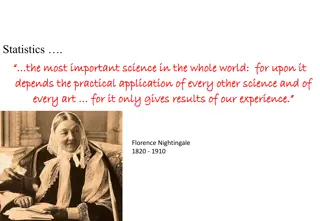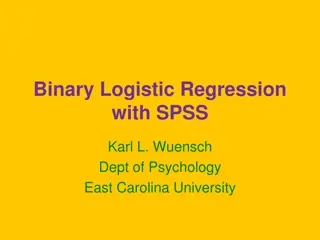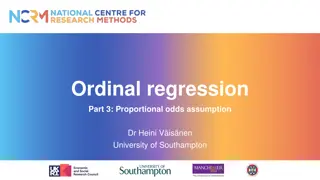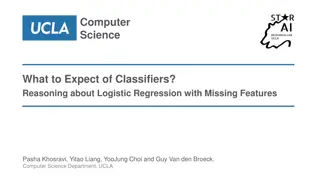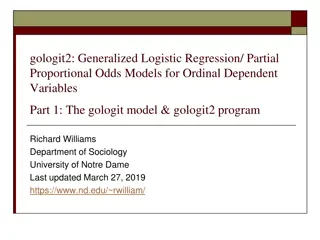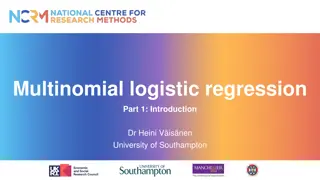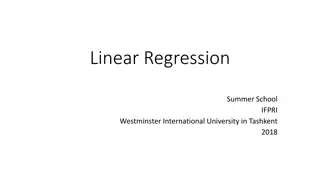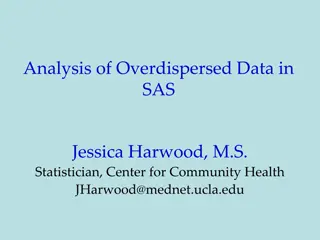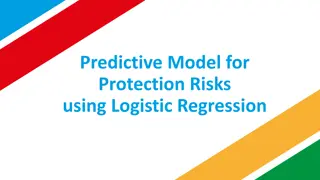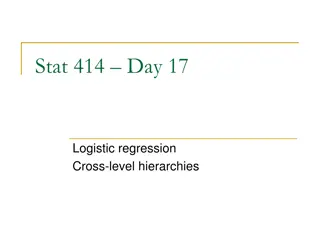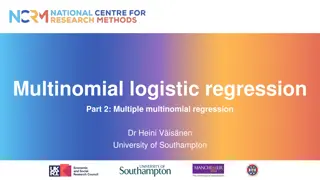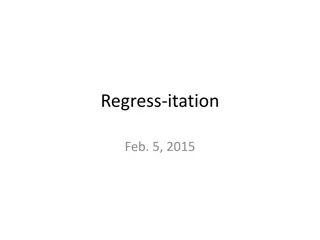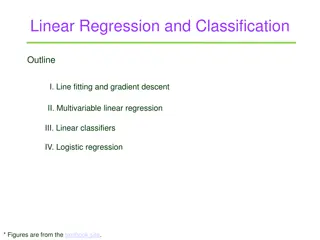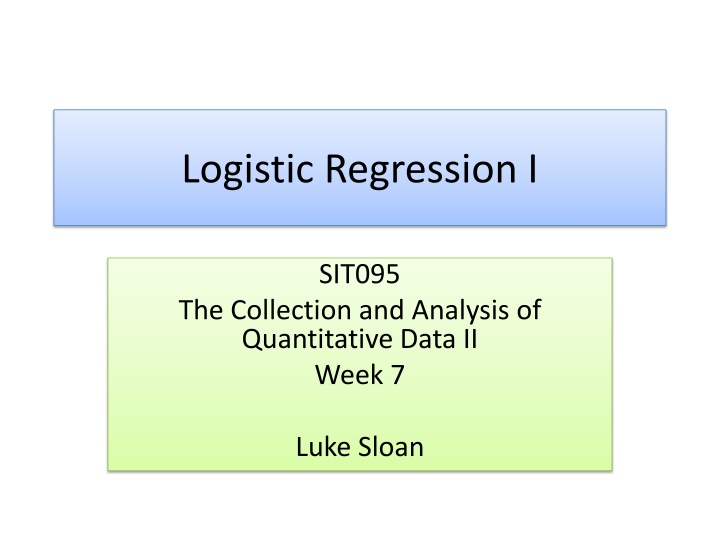
Logistic Regression in Quantitative Data Analysis
Explore the concepts of logistic regression, multiple linear regression, and their applications in predicting outcomes based on independent variables. Learn how to choose model variables, handle multicollinearity, and interpret results effectively.
Download Presentation

Please find below an Image/Link to download the presentation.
The content on the website is provided AS IS for your information and personal use only. It may not be sold, licensed, or shared on other websites without obtaining consent from the author. If you encounter any issues during the download, it is possible that the publisher has removed the file from their server.
You are allowed to download the files provided on this website for personal or commercial use, subject to the condition that they are used lawfully. All files are the property of their respective owners.
The content on the website is provided AS IS for your information and personal use only. It may not be sold, licensed, or shared on other websites without obtaining consent from the author.
E N D
Presentation Transcript
Logistic Regression I SIT095 The Collection and Analysis of Quantitative Data II Week 7 Luke Sloan
About Me Name: Dr Luke Sloan Office: 0.56 Glamorgan Email: SloanLS@cardiff.ac.uk To see me: please email first Note: Monday and Tuesdays only
Introduction Multiple (Linear) Regression Recap Intro To Logistic Regression Assumptions Choosing Model Variables Multicolinearity Coding and Dummy Variables Summary
Multiple (Linear) Regression - Recap Used to model the relationship between categorical or continuous independent variables and a continuous dependent variable Assumes that this relationship is linear Tells us what effect a one-unit increase in x will have on y using the coefficient ( B ) What if we have a categorical dependent?...
Multiple (Linear) Regression Recap II Linear regression uses the mean value this is useless for categorical data! With a continuous dependent variable we can observe whether linearity exists With a categorical dependent variable linearity cannot exist
Intro To Logistic Regression I Logistic regression allows us to predict the probability of y having a given value based on information from categorical and continuous independent variables Binary logistic model when categorical dependent has only two response categories (e.g. male/female) Multinomial logistic model when categorical dependent has more than two response categories (e.g. Lab/Con/LD/Green ) Allows us to calculate how a change in x affects the odds of y e.g. respondents who played games consoles were more likely to be male than female (odds increase of 4) or the odds playing a games console were 4 times higher for males than for females This is not the same as likelihood !
Intro To Logistic Regression II Examples of Applied Logistic Regression Predictors: Model Type: Dependent: Sex: Height, games console ownership, favourite colour etc Male/Female Binary Logistic Cancer: Chemical presence, size, aggression, drug resistance etc Malignant/Not Malignant Ethnicity: White/Non-White Income, highest qualification, occupation, religion etc Party Affiliation: Lab/Con/LD/Green Occupation, income, social class, house-ownership etc Multinomial Logistic Ethnicity: Income, highest qualification, occupation, religion etc White/Black/Asian/Other
Intro To Logistic Regression III y = a + bx b represents the slope of the line (the association between y & x ) e.g. how income or sex changes in relation to education or console ownership a represents the intercept (where the regression line crosses the vertical y axis) aka the constant x represents the independent variable (what we are using to predict y ) e.g. years in education or console ownership y represents the dependent variable (what we are trying to predict) e.g. income or sex Logarithmic Transformation P(y) = 1/(1 + e- (a + bx)) Probability
Intro To Logistic Regression IV Probability is the mathematical likelihood of a given event occurring i.e. probability of being male or female based on predictor variables Resulting value of the logistic regression equation (in this form) gives a value between 0 and 1 A value close to 0 means that y is very unlikely to have occurred A value close to 1 means that y is very likely to have occurred In our example, the outcome might be that the respondent is male Just as in multiple linear regression, the independent variables are given coefficients These coefficients are interpreted as odds rather than unit increases
Intro To Logistic Regression V The logarithmic transformation allows us to express a non- linear relationship in a linear way Thus the logistic regression equation expresses the linear regression equation using a logarithmic term (referred to as logit) This overcomes the problem of linearity and avoids violating this assumption Residuals can now be normally distributed (requires dependent to take more and two values!)
Intro To Logistics Regression VI Logistic Probability Model: Linear Probability Model: PROB(Male) = 1/(1 + e- (a + b Income )) PROB(Male) = a + b Income Prob (Male) Prob (Male) 1 1 0.5 0.5 Incom e 0 Incom e 0 Probability can exceed 1 or be less than 0 (i.e.unbounded) Logarithmic transformation bounds probability between 0 - 1
Intro To Logistic Regression VII To transform this logistic curve into a straight line (so we have linearity): PROB(Male) = 1/(1 + e- (a + b Income )) LOGIT(Male) = a + b Income This is the equation for the curve! This is the equation for a straight line! But both of these are complicated to interpret (mental gymnastics required!) so we talk about interpreting the effect of the independent variables in terms of odds ODDS(Male) = exp(a + b Income ) or ODDS(Male) = exp(a) exp (b Income ) or ODDS(Male) = exp(a) exp(b) Income Because the constant ( a ) does not change, exp(b) tells us the effect of the independent variable on the odds ratio ( ODDS(Male) )
Intro To Logistic Regression VIII EXAMPLE: There are 20 rainy days in March (out of 31 possible days) Probability: Probability of rain tomorrow: 20/31 or 2/3 The chance or likelihood of a specific event of outcome Odds: Odds of rain tomorrow: (Prob. of rain) / (Prob. no rain) or (2/3) / (1/3) or 0.6 / 0.3 or 2:1 or 2 The ratio of the probability that a particular event will occur to the probability that it will not occur Logit: Logit of rain tomorrow: LN(ODDS(rain)) or LN(2) or 0.69 The natural log of the odds
Intro To Logistic Regression IX Now we know what the technique is, how it can be useful and what it can tell us Running the model in SPSS and interpreting coefficients next week Multinomial logistic regression is very similar Don t worry if you haven t followed the equations! Rest of today model design and assumptions
Assumptions Assumption Issue Recommendation Sample should be large enough to populate categorical predictors. Limited cases in each category may result in failure to converge Use crosstabs at variable selection stage to identify low populated cells, may result in recoding Sample Size Cases that are strongly incorrectly predicted may have been poorly explained by the model and misclassified Identify cases through classification table and residuals use probability threshold scores Outliers Cases of data should not be related i.e. one respondent per dataset, not repeated measures - overdispersion Easy to avoid if the data collection has been conducted properly Independence of Errors Independent variables are highly inter- correlated (continuous) or strongly related to each other (categorical) Use collinearity diagnostics in linear regression model and test high tolerance values using chi-square or correlation Multicollinearity Does not assume normal distribution of predictor variables very useful!
Choosing Model Variables I Choosing the variables for your model is not guess work! You need to form hypotheses about which independents might be related to the dependent and why Perform hypothesis tests (chi-square, t-tests etc) to ensure that there is a relationship Understand that p-values of around 0.05 may be accepted there is no hard and fast rule Cell counts for crosstabs must not drop below 5 as this may result in model computation problems (e.g. if independent perfectly explains dependent) Use this opportunity to check for outliers and to identify categorical variables that may need recoding (collapsing to increase cell counts) start with frequencies These problems are much easier to deal with before running a model
Choosing Model Variables II Logistic Regression will exclude any cases where one or more of the independent variable values is missing When choosing variables you must look carefully at the amount of missing data 50% missing data from one independent variable will exclude 50% of sample from analysis This effect can accumulate to unacceptable levels EXAMPLE: In my PhD thesis I designed a multinomial logistic regression model with 22 original variables which excluded 90.56% of cases due to missing data. After excluding 7 of the worst offenders the percentage of included cases rose to 75.01%. This is a big deal!
Multicollinearity I Multicollinearity is particularly problematic for logistic regression models It occurs when one or more independent variables are related to each other (i.e. not independent!) It tends to reduce or negate the influential effect of either predictor and can also have cumulating effects on the rest of the model It must be prevented at all costs and is more common than you might think income, education, social class, age, house ownership, political party affiliation
Multicollinearity II To test for multicollinearity you need to use the collinearity diagnostics available under Linear regression in SPSS Eigenvalues smaller values mean that the model is likely to be less affected by changes to the measured variables Condition Index the square root of the ration of the largest Eigenvalue to the Eigenvalue of interest, disproportionately large values are indicative of collinearity Variance Proportions show % of variance of regression coefficient associated with relevant (small) Eigenvalue, more than two high values on the same dimension may be indicative of collinearity (I use =>0.30) As Eigenvalues shrink towards the bottom of the table collineairty tends to appear around the bottom, but similar Eigenvalues will prevent this Use as a diagnostic test investigate further with chi-square, t-tests or correlation
Multicollinearity III Collinearity Diagnosticsa Variance Proportions Parliamentary candidate professional association Did you apply for more .00 .00 .06 .80 .00 .00 .01 .09 .00 .01 .00 .00 .01 .00 .00 .00 .00 .00 .00 .00 .00 .00 .00 than one seat in 2006 ? charitable organisation Previously stood as a .00 .02 .16 .05 .56 .01 .01 .05 .02 .00 .02 .09 .00 .00 .00 .00 .00 .00 .00 .00 .00 .00 .00 More people seeking selection than seats? Local pressure group Highest educational Business Associates ethnicity, 2cat in a local pressure Community Groups Personal Friends local public body Party Members Trade unions Party Agents qualification Reputation Employers (Constant) local party (derived) PAPER3 STAND3 LikelyC group Condition Index Model 1 Dimension 1 2 3 4 5 6 7 8 9 10 11 12 13 14 15 16 17 18 19 20 21 22 23 Eigenvalue 12.915 1.000 1.427 3.008 1.207 3.271 .943 3.701 .844 3.911 .729 4.210 .651 4.454 .636 4.505 .578 4.725 .548 4.856 .496 5.103 .438 5.433 .417 5.563 .279 6.804 .185 8.361 .176 8.570 .139 9.626 .118 10.443 .094 11.707 .070 13.588 .051 15.843 .050 16.111 .008 40.929 .00 .00 .00 .00 .00 .00 .00 .00 .00 .00 .00 .00 .00 .00 .00 .00 .00 .00 .00 .00 .02 .03 .94 .00 .00 .00 .00 .00 .00 .00 .00 .00 .00 .00 .00 .00 .00 .00 .01 .00 .00 .00 .00 .07 .08 .83 .00 .00 .00 .00 .00 .00 .00 .00 .00 .00 .00 .00 .00 .00 .00 .08 .00 .16 .30 .00 .33 .10 .02 .00 .03 .07 .01 .21 .47 .00 .08 .07 .00 .03 .00 .00 .00 .00 .00 .00 .02 .00 .00 .00 .00 .00 .00 .01 .03 .00 .03 .00 .04 .12 .00 .03 .68 .00 .00 .00 .00 .02 .01 .00 .01 .00 .00 .00 .00 .00 .00 .01 .00 .01 .00 .01 .00 .02 .00 .00 .78 .04 .04 .00 .00 .01 .01 .03 .01 .00 .01 .01 .00 .03 .07 .00 .05 .25 .39 .01 .00 .01 .05 .00 .02 .00 .00 .04 .01 .01 .02 .02 .01 .00 .00 .00 .00 .00 .00 .00 .00 .00 .00 .00 .00 .00 .00 .00 .01 .01 .01 .00 .02 .12 .00 .21 .61 .01 .00 .00 .00 .00 .00 .00 .00 .00 .00 .00 .00 .00 .00 .01 .02 .01 .02 .03 .12 .51 .17 .11 .01 .00 .00 .00 .00 .00 .00 .00 .00 .00 .00 .00 .00 .00 .01 .00 .31 .33 .00 .06 .25 .00 .01 .00 .00 .00 .00 .00 .00 .00 .00 .00 .00 .00 .00 .00 .00 .00 .87 .00 .03 .00 .04 .01 .01 .02 .00 .00 .00 .00 .00 .00 .00 .00 .00 .00 .00 .00 .00 .00 .03 .02 .05 .21 .17 .26 .17 .06 .03 .00 .00 .00 .00 .00 .00 .00 .00 .00 .00 .00 .00 .00 .00 .02 .02 .00 .09 .01 .09 .40 .28 .09 .00 .00 .00 .00 .00 .00 .00 .00 .00 .00 .00 .00 .00 .00 .05 .00 .10 .18 .51 .00 .00 .07 .04 .03 .00 .00 .00 .00 .00 .00 .00 .00 .00 .03 .00 .01 .00 .57 .02 .07 .10 .15 .00 .01 .01 .00 .00 .00 .07 .06 .00 .01 .07 .00 .60 .01 .01 .11 .00 .00 .00 .00 .02 .01 .00 .00 .00 .00 .03 .00 .00 .01 .00 .00 .00 .04 .01 .00 .74 .11 .01 .00 .01 .04 .00 .00 .01 .00 .00 .00 .00 .00 .00 .00 .07 .02 .00 .01 .00 .03 .01 .15 .57 .03 .01 .00 .02 .00 .02 .01 .01 .03 .00 .00 .00 .00 .00 .09 .05 .04 .03 .04 .02 .10 .00 .16 .00 .01 .45 .00 .00 .00 .00 .00 .00 .00 .00 .00 .00 .00 .04 .01 .02 .00 .01 .03 .02 .00 .01 .00 .05 .71 .00 .00 .06 .00 .01 .00 .00 .01 .01 .01 .00 .03 .02 .00 .01 .07 .41 .01 .02 .06 .25 .10 .00 .00 .00 .01 .00 .00 .00 .00 .00 .00 .00 a. Dependent Variable: USE THIS VAR
Coding and Dummy Variables Recoding categorical predictors into binaries Sex is a binary (1=male, 0=female recode) E.g. Live in city , rural , suburban area all in single variable needs recode into dummy variables: City yes/no (1/0) Rural yes/no (1/0) Suburban yes/no (1/0) This allows us to make statements such as those who lived in a city were less likely to feel safe and those who lived in a rural area were more likely to feel safe Also important for ordinal variables (e.g. highest qualification) as respondents with a degree will also have A-Levels and GCSEs this is an assumption in a categorical variable with several responses and needs to be made explicit for logistic regression Generally speaking, all categorical variables should be recoded into dummies SPSS will do this for you but you need to be aware that it is happening (I ll show you next week)
Workshop Task Investigate the LFS dataset Select variables for a binary logistic model Use the workshop slides on the portal to help

